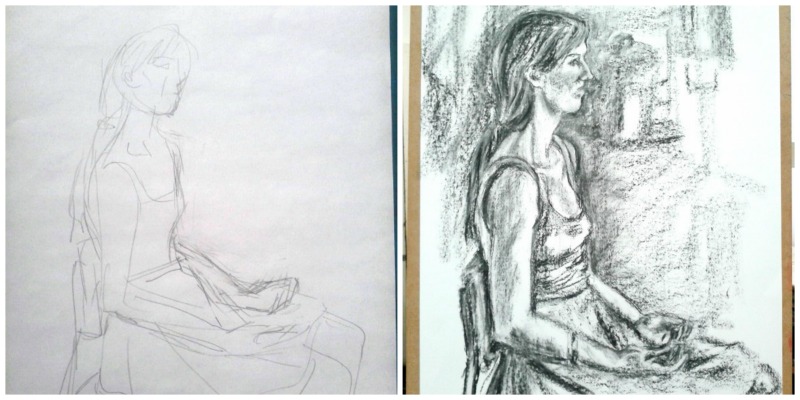
Today I’m feeling over the moon.
Well, not really over the moon. Let’s just say I feel inspired. And it has nothing to do with the weather (although a spot of sunshine never bothers me, especially in the early days of Spring)
Why the excitement?
Well, there are a couple of things I’ve done lately and they seem to lend themselves to a blog post.
Let’s see how it goes.
The first thing I did, some days ago, was to buy a great book on impulse. Its name is ‘Writing on both sides of the brain’ by Henrietta Anne Klauser.
The second thing I did was to join a local arts class.
This was also somewhat impulsive, although I had been thinking about it for ages, always finding excuses not to do it: Shouldn’t I just attend business courses, photography courses, networking workshops? I’d have to book a day off just to go to class in the middle of the day. Could I afford not to be 24-7 available for my other job?
The answer was yes.
I can afford it (agency work or not, this time it felt important to put myself first. Money, business, life… would go on some way or another).
And I’ve just had the realisation that both events are connected.
Let me explain why.
On the book there’s an interesting reflection about the roles of the more analytical, critical side of the brain -the left- and the more creative, inspired side -the right-. When we write we tend to have both sides pushing against each other, with the creative side putting ideas forward whilst the left side simultaneously criticises them and makes us stop to over-analyse them.
Thus writer’s block ensues. Or a similarly unpleasant experience of writing seventeen (17!) drafts of my first Open University assignment, many years ago.
The writer’s block also pokes his head every now and then when I start writing on a particular topic on my blog: Is this ‘businessy’ enough? Who is going to care about it? Am I just writing for the sake of listening to myself? Why on earth would someone even want to read about X topic? (And so on and so forth)
The book explains some methods to make both sides of the brain work together, such as by focusing on either aspect at the time of writing. Thus, when you’re writing just write. Write with grammar mistakes, with spelling mistakes, with nonsensical anecdotes interspersed in your writing. Do not stop to analyse anything until you’re finished. Then, when you’re finished, just let the critic come out and do its job: edit. Find the right words, clean up the redundant expressions, etc.
The second event, my arts class comes to play.
I should share that I attended drawing lessons once upon a time. Around the ages of 7 and 8 years old. I used to attend 5 days a week, after school, until I just couldn’t take it any more. (A story for some other time: I’m sure it will come handy for the right post)
Anyhow.
It’s early days in the course, but I already feel I’m getting in touch with my creative side. What I learned years ago is still there, lurking, giving me some ideas and helping me put up with the discipline.
I confess: I loathe having anyone telling me that I’m doing something wrong. And having to admit that they are right. But they are. And I admit it. And I come out of the class feeling upbeat and looking forward to the next one. It helps when I see the results (Picture above). And it also helps when I get some nice comments from my classmates and from the teacher. And my friends on Facebook…
Why sketch?
What surprised me in the class is that we start our drawings by doing a quick sketch of the model. Nothing too laborious, but still something that our teacher comments on: «Are these proportions right? Where does the arm finish? Where does the back of the chair touch their back?» etc. So we sketch. We get an idea of what we are going to work on («That body is too small for the paper. You will struggle with the details. Make her bigger»).
And once we’ve done the sketch we toss it aside. Not to be checked, not to be compared. The sketch’s job is simply to help us envision the final image: the model’s proportions, the shadows, how much of the person we’ll be drawing…
That seems similar to the way the left and right side of the brains work, according to the book: One side to capture the inspiration, the idea, the flavour of the drawing (or the blog post). And the other one -the more critical one, the analytical, the perfectionist to go over the post, or the drawing, to round it up, to make it complete, to delete what is redundant or repetitive or out of proportion or outside the topic in question.
Interesting…
***(2017 update) Time to get on a new chapter and delete all my previous posts about photography: During my journey into art I decided to stop offering photography services.
All related posts and articles since 2011 no longer have a place on my website, so there’s no point keeping them here to confuse my future readers***
Thanks for reading this.